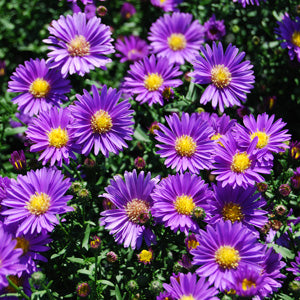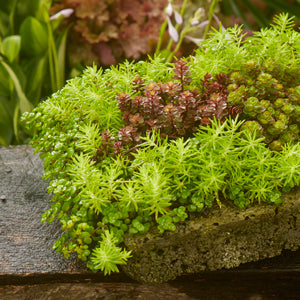 By Karen Weir-Jimerson
By Karen Weir-JimersonGardening makes your yard look great, your neighbors secretly admire you, and your real estate prices go up (really!). But did you know that it also does wonders for your health?
Gardening is a work out! Lifting, stretching, bending, walking: Use your yard and garden as a place to exercise. Here are some ways that gardening makes you more fit, flexible, and fabulous.
Burn Some Calories in the Garden
Planting, pruning, mowing—they all involve movement, which burns calories. Feel the burn with these activities:
--Landscaping (moving bags of soil, lifting rocks, digging): 400 to 600 calories per hour
--Pulling weeds, planting flowers: 200 to 400 calories per hour
--Raking and bagging leaves: 350 to 450 calories per hour
--Lawn mowing: 250 to 350 calories per hour
TIP: Spend 30 minutes a day in the garden instead of going to the gym. Multitask your way to a trimmer body and more beautiful garden.
Become More Limber and Flexible
Gardening activities, such as raking leaves and pruning shrubs, require you to bend, twist, and stretch. Gardening also requires hauling (think bags of leaves and bundles of brush). Pulling weeds requires that you bend and flex from the waist. All these actions help increase flexibility and build muscle.
TIP: Increase flexibility and balance by doing yoga stretches that specifically address areas of movement for gardening activities, such as back, legs, arms, and shoulders.
Build Muscle Mass
Landscape work, such as planting shrubs, installing a patio, or adding hardscaping elements like stones or a bird bath, requires hefty weight lifting. Landscape stones can weigh from a few pounds to a several hundred pounds (don’t try to move these). Carrying bags of mulch and potting soil from your car to your potting bench gives you an upper body workout, and holding them out and away from your body works your core.
Note: Be careful when lifting heavy objects; always lift from the knees to protect your back.
TIP: If undertaking a strenuous day of gardening, do warm-up exercises first. Dr. Leonard Perry, Extension Professor at the University of Vermont Extension, says that overdoing in the garden can lead to sore muscles. Especially after a sedentary winter. In a web article he says, “Many gardening activities, such as hoeing, digging, and raking, can cause tightness in your shoulders.” To relieve this, he suggests shoulder shrugs. “Simply raise your shoulders slowly towards your ears, hold a few seconds, and slowly release. Do this three or four times, resting a few seconds between each repetition.”
Count Steps
Do you have a step counter? It’s amazing how many steps that simple gardening tasks rack up. Be conscious of building steps into your gardening routine. When planting, hand carry flats, pots, and tools to the garden individually, making several trips, rather than piling them into a wheelbarrow or garden cart. Use a push mower rather than a rider to increase steps while mowing. Or better yet, invest in a manual push mower (instead of using a walk-behind self-propelled push mower) and you’ll get a core and arm workout as well. Put away electric devices (hedge clippers, edgers, blowers) and opt for hand trimming, edging, and sweeping—which will give you an upper body work out along with adding steps.
TIP: According to a calculator on the University of Vermont website, 30 minutes of light gardening is roughly equal to 3480 steps.
Get Your Vitamin D Dose for the Day
Outdoor gardening means exposure to sunlight, which is an easy way to get your daily dose of Vitamin D. According to an article in U.S. News, “The government's dietary recommendations are 200 IUs a day up to age 50, 400 IUs to age 70, and 600 IUs over 70. But many experts believe that these recommendations are far too low to maintain healthful vitamin D levels.” A fair-skinned person outdoors midday for 10 minutes produces about 10,000 international units of Vitamin D. Dark-skinned and elderly folks produce less Vitamin D, so they may need to spend more time in the sun to get the same benefit.
TIP: If you are outdoors for several hours, apply sunscreen after fulfilling the amount of sun exposure to get your daily dose of Vitamin D.
 Make Gardening a Social Activity
Make Gardening a Social Activity
Gardening is more fun when you join up with a friend or share your interest with a child—and that relationship building is good for you too. Community gardens allow you to share your love of gardening as well as meeting new people. You can learn tips from experienced gardeners or mentor those who want to learn. Growing produce and flowers is a beautiful way to connect to the Earth—as well as spending growing time with your kids and folks in your neighborhood.
TIP: The American Community Gardening Association has a locator tool on their site so you can find a community garden near you.
Relieve Anxiety and Stress
Gardening can make you mentally healthy as well. A study in the Netherlands (as reported in a recent article on the AARP website) “suggests that gardening fights stress even better than other hobbies. Participants completed a stressful task and were then told to read inside or go outdoors and garden for 30 minutes. The gardening group reported better moods afterward, and their blood tests showed lower levels of the stress hormone cortisol.”
TIP: Use gardening to power down after a stressful day. Water plants, do a little weeding, deadhead flowers, or prune a shrub. Your garden will shine and you’ll be a lot more calm, happy—and healthy.

















